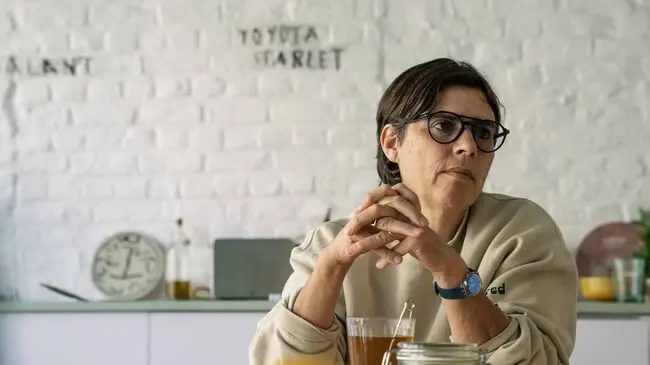More is more

The youth has taken over gallery E of MSK! 24 young artists were selected after an open call to display their artworks in the museum space, inspired by the MSK collection. The exhibition was organized by Schoonvolk, MSK’s youth collective, and consists of people between the age of 16 and 26 from various backgrounds who want to make the museum more accessible for young visitors. They adopted the perspective of the 19th-century salon to bring together an eclectic and colourful assembly of artworks.
I remember learning about the 19th-century salon: the old catalogues containing an infinite list of names and artworks, the paintings made of the salon depicting a collection of contrasting art pieces, the humorous caricatures of Honoré Daumier which he drew at the Parisian salons… It fascinated me. The first salon was organized in the 17th century in Paris and became one of the most prestigious art happenings in Europe. It was connected to the art academy and gave artists a platform to exhibit their new works. However, the salon was very traditional. For this reason, in 1863 the Salon des Réfusés was organized as a place for the rejected artists, often displaying more radical or innovative artworks. The first salon in Ghent took place in 1792.


Salon des Jeunes was inspired by the salons in Ghent and aims to be a contemporary version of the big art exhibition. Luckily, there are some changes compared to the 19th century: a lot of women had the opportunity to participate in this exhibition, which was not the case in the 19th-century salons. There is also a big diversity in terms of media, ranging from sculpture and painting to drawing, photography and textile. The young participating artists were inspired by works from the MSK collection – five works by well-known artists, made when they were young as well: Skeleton Looking at Chinoiserie by James Ensor, Jupiter and Antiope by Anthony Van Dyck, Armand Heins by Théo Van Rysselberghe, George Minne’s Mother Grieving over her Dead Child and Theodore Rousseau’s A Quarry.


When walking into the exhibition, you are immediately greeted by 2MMJ + 9C from Time Dobbs. He made the biggest artwork on display, painting a whole wall with spray paint and acrylic paint. It’s a good start to the exhibition: it immediately evokes this salon feeling where you are overwhelmed, impressed and immersed in the artworks. However, in contrast to the chaotic and confusing display of the 19th-century salon, 2MMJ + 9C rather creates a calm sensation. After all, Dobbs was inspired by the calming emotions of Van Rysselberghe’s work, which he translated into an abstract piece.

My favourite piece of the exhibition is Magali Laroy’s 62 km, a sculpture-like artwork consisting of a mannequin hanging from a metal construction with black paint and pink textile. What interests me most about this work is its layered character, both in terms of material and interpretation. Based on George Minne’s sculpture, Laroy conceived the work as ‘a dialogue of clashing with oppositions and finding syntheses’. Hereby distance is the central concept, carrying notions of letting go and linking up on an emotional and measurable level. But when I looked at the work, I saw more. The hardness of the metal chains juxtaposed with the softness of the mannequin form and textile, the delicate pink fabric in contrast with the black dripping paint. There is a sentiment of suffering in it, but also comfort, compassion, consolation and the idea of moving on by the fluent lines of the sculpture.
Often people have the misconception that an artist makes masterpieces effortlessly, while in reality there is a lot of anxiety, overthinking, frustration and doubt
Then there’s Charlot Vael’s Artblock which takes the form of a family game. In my opinion, it was a very light work: I even laughed a bit when looking at it (in a good way). It’s about the process of making an artwork, which is not going all that smoothly. Often people have the misconception that an artist makes masterpieces effortlessly, while in reality there is a lot of anxiety, overthinking, frustration and doubt during the making process. Charlot Vael challenges this mistaken belief by depicting Arman Heins, the painter in Theo Van Rysselberghe’s work, in all kinds of phases during an artist’s block: an uninspired moment solved by drinking a lot of coffee, smoking cigarettes, reading, playing a game of darts or just staring into the void.


In Salon des Jeunes, the visitor can expect a diversity of colours and materials, which is the strength of the exhibition in conveying the salon feeling. Maybe it would have been nice to also adopt the salon display by making the set-up more chaotic and experimental. It would have been interesting to see all these young artists brought together in a laboratory-like environment while the five artworks from the MSK collection are displayed classically opposite. Nevertheless, it’s a good thing that an institution like MSK now welcomes young artists and gives them a platform. With this exhibition, the visitor is taken into account as well. They can leave behind a message on postcards, which are then presented on shelves. This creates a feeling of connection and participation. A table and chairs in the middle of the space invite visitors to discuss and reflect upon the exhibition, by which the museum turns away from the perception of an exhibition as a silent place for contemplation. Lastly, the artists wrote their own texts about their artworks, which is a nice touch. I would like to quote the ending of Anna Touré’s text, which, according to me, is the best text of them all: 'Nin woongo tond on loogé'. Welcome to the time before memories.
Different Class works with the interest of their community at heart.
Our work’s purpose is to foster a solid network for independent artists, those who love them, and those who want to support them. Become a member to contribute to the local Belgian art scene.





